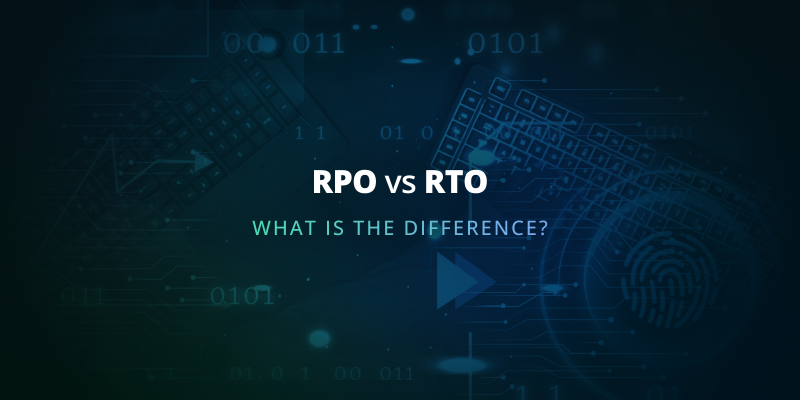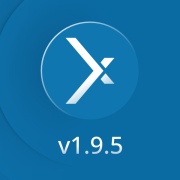
What Is RTO? What Is RPO? What Is the Difference Between RTO and RPO? A Comprehensive Guide to RTO vs. RPO
When it comes to disaster recovery and business continuity, two key parameters stand out: Recovery Point Objective (RPO) and Recovery Time Objective (RTO). Understanding RPO and RTO is essential for safeguarding your company against any unforeseen events or disasters that could disrupt your operations.
But what exactly are these parameters, and how do they influence your organization’s ability to bounce back from a nightmare scenario? In this article, we’ll define and analyze these crucial concepts, as well as explore real-world examples and standards of their applications.
Read on to learn:
- What is RPO, what is RTO, and what are the differences between them?
- What are the core applications of RTO and RPO?
- What are the best practices for continuous improvement and monitoring of RPO and RTO?
What Is RPO vs. RTO?
Recovery Point Objective (RPO) and Recovery Time Objective (RTO) are essential components of disaster recovery and business continuity planning. These metrics help businesses determine their maximum allowable downtime, backup frequency, and recovery procedures, ensuring a swift and effective response to any potential disruptions.
In this section, we’ll delve deeper into the definitions and purposes of RPO and RTO, shedding light on their significance in the broader context of disaster recovery and business continuity planning.
What Does Recovery Point Objective (RPO) Mean?
A Recovery Point Objective (RPO) is a metric used to evaluate how much data loss a business can afford during a disaster, as well as the frequency at which data backups should be performed. In other words, RPO addresses the question: How much data can a company afford to lose before the consequences become unacceptable? Determining the appropriate RPO requires a thorough examination of all relevant data sets, as it plays a critical role in establishing the frequency of data backups and the amount of data that could be lost in the event of a disaster.
By defining RPO, organizations can create a disaster recovery strategy tailored to their specific needs and priorities, ensuring that mission-critical data is protected and minimizing the potential impact of data loss on business operations. In essence, RPO helps businesses strike the right balance between data protection and resource allocation, enabling them to make informed decisions about their scheduled backup and data recovery processes.
What Does Recovery Time Objective (RTO) Mean?
Recovery Time Objective (RTO), on the other hand, is the time required to restore IT infrastructure and services following a disaster for business continuity. In simpler terms, RTO is the duration a company can afford to have its systems down before the consequences become unacceptable, impacting normal business operations. Determining RTO is a responsibility that typically falls on senior management, and it involves conducting a Business Impact Analysis (BIA) as part of the overall business continuity planning process.
Calculating RTO is essential to ensuring that a business can return to its normal operations as quickly as possible following a major incident. By establishing RTO targets, organizations can develop a disaster recovery plan that prioritizes the restoration of critical systems and infrastructure, minimizing the potential impact of downtime on business operations and customer satisfaction.
Short Summary of RTO vs. RPO
-
RPO and RTO are essential components of disaster recovery and business continuity planning, with different purposes, priorities, and methodologies.
-
Assessing potential financial losses associated with downtime is key to effective strategies for both metrics.
-
Periodic testing & review of plans is critical to ensure data recoverability & meet industry regulations/standards as businesses evolve.
What Are the Key Differences Between RPO and RTO?
While both RPO and RTO play crucial roles in disaster recovery and business continuity planning, understanding the differences between RTO vs RPO is essential for developing effective strategies. They serve different purposes and measure distinct types of information.
In this section, we’ll explore the key differences between RPO and RTO, focusing on their purpose and priority as well as the methods used to measure and calculate these metrics.
Purpose and Priority
One of the main distinctions between RPO and RTO lies in their purpose. RPO is primarily concerned with the impact of data loss on overall customer transactions, while RTO focuses on the restoration of applications and systems to facilitate a return to normal operations. In essence, RPO helps businesses determine how much data they can afford to lose and how often they should perform backups, while RTO helps them establish the timeline for restoring their IT infrastructure and services following a disaster.
In terms of priority and cost, RTO may be more expensive than RPO, as RTO determines the timeframe required to restore the entire business infrastructure, not just the data. Achieving a balance between RTO and RPO is essential for businesses to ensure the protection of their assets with minimal disruption and data loss. Setting low RTOs for all assets may not be practical or cost-effective, so it’s crucial to prioritize the restoration of critical systems and infrastructure based on their impact on business operations.
Measurement and Calculation
Another key difference between RPO and RTO is the way they are measured and calculated. RPOs are relatively straightforward to calculate, given the uniformity of data variables. In contrast, RTO restoration times require consideration of multiple factors, such as the time of restoration, analog time frames, and the day the event occurs. While data backups can be automated with relative ease for RPOs, RTOs necessitate the involvement of all IT operations in the recovery process, rendering automation virtually unattainable.
Understanding these differences is vital for businesses to develop a comprehensive disaster recovery strategy that safeguards their assets and ensures minimal disruption in the event of a disaster. By taking into account the unique challenges associated with measuring and calculating RPO and RTO, organizations can implement the most effective strategies for data protection and disaster recovery.
Understanding these differences is vital for businesses to develop a comprehensive disaster recovery strategy that safeguards their assets and ensures minimal disruption in the event of a disaster. By taking into account the unique challenges associated with measuring and calculating RPO and RTO, organizations can implement the most effective strategies for data protection and disaster recovery.
How to Implement Effective RPO and RTO Strategies?
Mapping out recovery objectives and comparing downtime costs with the impact on the company is essential for implementing a sensible data backup and disaster recovery strategy. In this section, we’ll discuss best practices for assessing business impact and balancing costs with recovery objectives, ensuring that your business remains resilient in the face of adversity.
Assessing business impact involves understanding the potential financial losses associated with downtime, as well as the potential impact on customer satisfaction and brand reputation. It’s important to consider the cost of lost productivity, lost sales, and other indirect costs.
Assessing Business Impact Analysis
The business impact of RPO and RTO can be significant, affecting a company’s financial losses, reputational damage, legal ramifications, and decreased productivity. That’s why it’s crucial for businesses to conduct a thorough business impact analysis (BIA), which involves evaluating the potential consequences of downtime and data loss on various aspects of the business, including lost revenue, salaries, stock prices, and overall expense. By understanding the potential impact of RPO and RTO on their operations, businesses can make informed decisions about their disaster recovery plans and prioritize the protection of mission-critical data and systems.
Balancing the costs and recovery objectives is also essential for businesses to ensure their data is safeguarded while adhering to a budget. This involves considering factors such as the cost of implementation, the volume and type of data to be backed up, the duration of the backup process, and the duration of the recovery process. By carefully weighing these factors, businesses can develop a disaster recovery strategy that strikes the right balance between data protection and resource allocation.
Balancing Costs and Recovery Objectives
When assessing the impact of downtime costs on the company, it is important to consider factors such as lost revenue, salaries, stock prices, and the expense of the business. By balancing these costs with the desired recovery objectives, companies can implement a disaster recovery strategy that effectively safeguards their data without breaking the bank.
One approach to achieving this balance is by utilizing virtualized storage clusters for backups, which offer several advantages, including shortened backup windows, increased capacity, and the ability to back up multiple workloads simultaneously.
Another important aspect of balancing costs and recovery objectives is ensuring the high availability of mission-critical data. Secondary storage should always be active in order to achieve continuous data replication from primary storage. This ensures that the data stored is backed up at all times. By leveraging technology and implementing flexible, scalable, and focused solutions, businesses can effectively protect their data while minimizing the potential impact of downtime on their operations.
What Are Real-World Examples of RPO and RTO Application?
To better illustrate the difference between RPO and RTO objectives, let’s consider two scenarios in a bank. In the first scenario, the bank schedules backups twice a day at specific times to ensure that the maximum amount of data loss is within the acceptable limit. This is done to guarantee that the organization can recover from a disaster with minimal data loss.
In the second scenario, the bank establishes a system that can be recovered within a certain amount of time, such as 24 hours, to guarantee that the organization can continue to operate in the event of a disaster. These examples highlight the key differences between RPO and RTO and their applications in real-world scenarios.
While RPO focuses on data protection and minimizing data loss, RTO emphasizes the restoration of systems and infrastructure to ensure business continuity. By understanding the unique challenges and objectives associated with each metric, businesses can develop a comprehensive disaster recovery strategy that effectively safeguards their assets and ensures minimal disruption in the face of adversity.
Continuous Improvement and Monitoring of RPO and RTO
Constant assessment, testing, and measurement of RTOs and RPOs are necessary to prepare for any shortcomings and to ensure that recovery objectives remain aligned with evolving business needs.
In this section, we’ll explore best practices for periodic testing and review, as well as strategies for adapting RPO and RTO to changing business requirements, ensuring that your organization remains resilient and agile in the face of unforeseen challenges.
Periodic Testing and Review
Periodic testing and review are essential components of an effective RPO and RTO strategy, as they help organizations ensure that their data is retrievable in the event of an unforeseen event or disaster. The process for periodic testing of RPO involves regularly assessing the capability of recovering data to a prior point in time, within the maximum allowable amount of data loss as defined by the organization’s Recovery Point Objective (RPO). This testing should be conducted periodically to guarantee that the organization’s RPO strategy is effective and that any potential issues are identified and addressed.
By regularly testing their RPO and RTO strategies, organizations can gain valuable insights into the effectiveness of their disaster recovery plans and identify areas for improvement. This proactive approach not only helps businesses safeguard their data and minimize the potential impact of downtime but also ensures compliance with industry regulations and standards.
Periodic testing and review are essential components of an effective RPO and RTO strategy, as they help organizations ensure that their data is retrievable in the event of an unforeseen event or disaster. The process for periodic testing of RPO involves regularly assessing the capability of recovering data to a prior point in time, within the maximum allowable amount of data loss as defined by the organization’s Recovery Point Objective (RPO). This testing should be conducted periodically to guarantee that the organization’s RPO strategy is effective and that any potential issues are identified and addressed.
By regularly testing their RPO and RTO strategies, organizations can gain valuable insights into the effectiveness of their disaster recovery plans and identify areas for improvement. This proactive approach not only helps businesses safeguard their data and minimize the potential impact of downtime but also ensures compliance with industry regulations and standards.
Adapting to Evolving Business Needs
In today’s dynamic business environment, it’s crucial for organizations to adapt their RPO and RTO strategies to changing requirements and priorities. This involves incorporating change management protocols, remaining adaptive and agile, leveraging technology to capitalize on data, providing flexibility, scale, and focus, and collaborating with the organization to define recruitment objectives and analyze existing processes.
Furthermore, RPO providers guarantee that the entire recruitment process is aligned to meet the client’s goals and challenges. By staying flexible and responsive to evolving business needs, organizations can ensure that their RPO and RTO strategies remain effective and relevant, safeguarding their data and ensuring business continuity in the face of unforeseen challenges.
By leveraging technology and providing flexibility, scale, and focus, businesses can effectively protect their data while minimizing the potential impact of downtime on their operations.
Frequently Asked Questions About RPO and RTO
What Is the Difference Between RTO and RPO in Azure?
Recovery Time Objective (RTO) and Recovery Point Objective (RPO) are two critical concepts used in Azure to ensure data availability and continuity. RTO sets the maximum amount of time it should take to restore normal operations following an outage or data loss, while RPO determines the maximum amount of data an organization can tolerate losing.
Both are important in keeping applications up and running in Azure.
What Is the Difference Between RPO and RTO in AWS?
RTO and RPO are both essential elements of AWS resiliency. RTO measures the maximum amount of time for an organization to restore normal operations following an outage or data loss, while RPO represents the maximum amount of data the organization can tolerate losing.
Thus, RTO focuses on restoring service quickly while RPO is concerned with preserving data.
What Is RTO and RPO in Simple Terms?
RTO and RPO are critical terms to consider in any business continuity plan. RPO stands for Recovery Point Objective, which is the maximum allowable amount of data loss a business is willing to tolerate.
Meanwhile, RTO stands for Recovery Time Objective, which is the maximum amount of time that an organization can wait before their operations must be restored.
Summary of RTO and RPO
In conclusion, understanding the differences between Recovery Point Objective (RPO) and Recovery Time Objective (RTO) is essential for developing an effective disaster recovery strategy and safeguarding your business against unforeseen events. By defining these key parameters and tailoring your approach to meet your organization’s unique needs, you can strike the right balance between data protection and resource allocation, ensuring minimal disruption and data loss in the event of a disaster.
As the business landscape continues to evolve, it’s crucial for organizations to stay agile and adaptive, constantly reviewing and updating their RTO and RPO strategies to remain resilient in the face of adversity. By following the best practices outlined in this blog post, you can ensure that your business remains well-prepared for any challenges that may lie ahead, safeguarding your data and ensuring business continuity no matter what the future holds.







